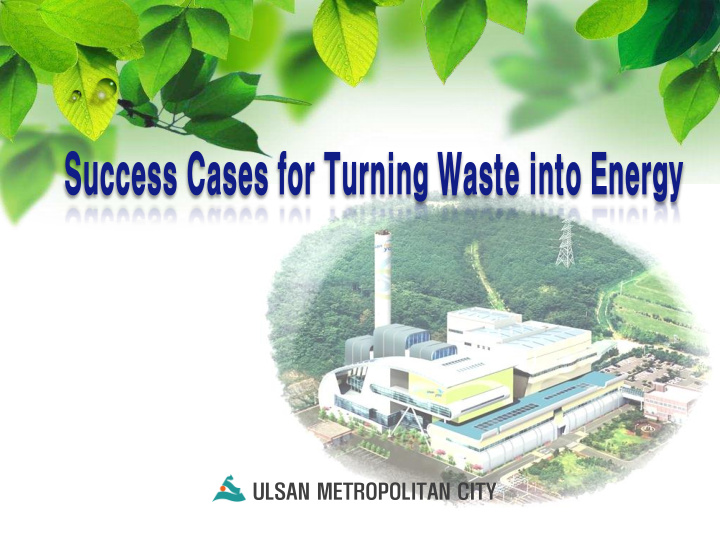



ULSAN METROPOLITAN CITY
I. Waste Generation and Disposal II. Waste Treatment Policy III. Steam Generation Business for Daily Waste Incineration Plants IV. Business Results
I. Waste Generation and Disposal Daily Waste • Generation : 1,454tons/day (in 2015) • Type : Household Waste, Food Waste, Etc. • Disposal : Recycling 785t/d, Incineration 598t/d, Landfill 71t/d → Public Facilities : 1 Landfill, 3 Incineration Plants, 2 Food Waste Disposal Facilities Industrial Waste • Generation : 11,684tons/day (in 2015) • Disposal : Recycling 8,774t/d, Incineration 874t/d, Landfill 1,675t/d, OTHERS 379t/d → Private Facilities : 5 Landfills, 6 Incineration Plants, 181 Recycling Plants
II. Waste Treatment Policy Social Condition Rapid Inflow of Population, Building an Industrial Complex, Increased amount of Waste Policy of Advanced Waste Treatment (Landfill) Mixed Sanitary Landfill - no food waste landfill since 2005, but recycling - separate treatment for recycling waste by type (Incineration) Separating Combustible Waste - incineration an combustible waste since 2000 ※ separately keeping, collecting and disposal of waste by type, nature and condition
II. Waste Treatment Policy Paradigm Shift in Treatment of Daily Waste < F OOD WAS T E + S E WAGE S L UDGE > < INCINERATION • anaerobic digestion Bio io • generating biogas STEAM WASTE > Met ethane • using incineration RESOURCE heat, generating steam • supplying to nearby ` companies < F OOD WAS T E + ENERGY • residual steam to L I V E S T O C K M A N U R E > electricity < LANDFILL GAS > • anaerobic digestion STEAM • recovering and LFG • generating biogas refining methane • generating steam • auxiliary fuel for incineration
II. Waste Treatment Policy Food Waste + Sewage Sludge Food Waste + Livestock Manure
II. Waste Treatment Policy • Incineration Plant : 650tons/day(3 plants) ☞ medium ∙ high pressure steam STEAM 1,200tons/day • Food Waste (+ Livestock Manure) Disposal Facility : 150tons/day ☞ row pressure steam 70tons/day LFG • Landfill : area143,000 ㎡ ☞ Landfill Gas 6000 ㎥ /day • Food Waste (+ Swage Sludge) Bio io Disposal Facility : 390tons/day Met ethane ☞ bio methane 26,000 ㎥ /day
III. Steam Generation Business INCINERATION PLANT STATUS • capacity : 650tons/day( 200tonsⅹ2, 250tonsⅹ1 – BTO construction ) • main facility : waste heat boilersⅹ3 (29tons/hrⅹ2(medium), 42tons/hrⅹ1(high)) , turbine generator 1.5 MW/hr • steam supply : 45tons/hr(supply facility 70tons/hr), FACILITY OPERATION 1.2km for each medium and high pressure pipe • Operation Date : 5. 2000(200tonsⅹ2), 10. 2012(250tonsⅹ1) 토양 측정항목 확대 및 기준강화 중앙정부 건의 • Management : Ulsan Green inc.(over 320 operating 토양 관련 교육 및 홍보 강화 : 학교 , , 기업체 대상 days per year) • Steam Supply : Nearby Company(Hyosung), Steam Unit Price – based on the fuels
III. Steam Generation Business < DAILY WASTE DISPOSAL FACILITY> LANDFILL INCINERATION PLANT
III. Steam Generation Business STEAM BUSINESS STATUS • Background - Discovering an alternative energy source - Reducing greenhouse gas - Expanding regional economic and budget expansion ⇒ Establishing mutual trust between administration and company, active introduction of energy efficiency technology • Measure - Establishing the system : Steam supply facility and Supply method, Selecting recipients - Signing the facility use agreement : Ulsan City, Hyosung inc. (Technical advisory → EIP business group ) - Improving the energy system for expanded incineration plants (electricity → High Pressure) , Economic feasibility doubled • problems overcome - applying construction cost within steam price ( installing the pipe by recipients) - persuading BTO construction companies for expanded incineration plants,
IV. Business Results Regional economy vitalization, a leading model of low-carbon green growth
Energy R Recovery f from W Waste , A Leading Model o of C Creative Economy ULSAN METROPOLITAN CITY
Recommend
More recommend